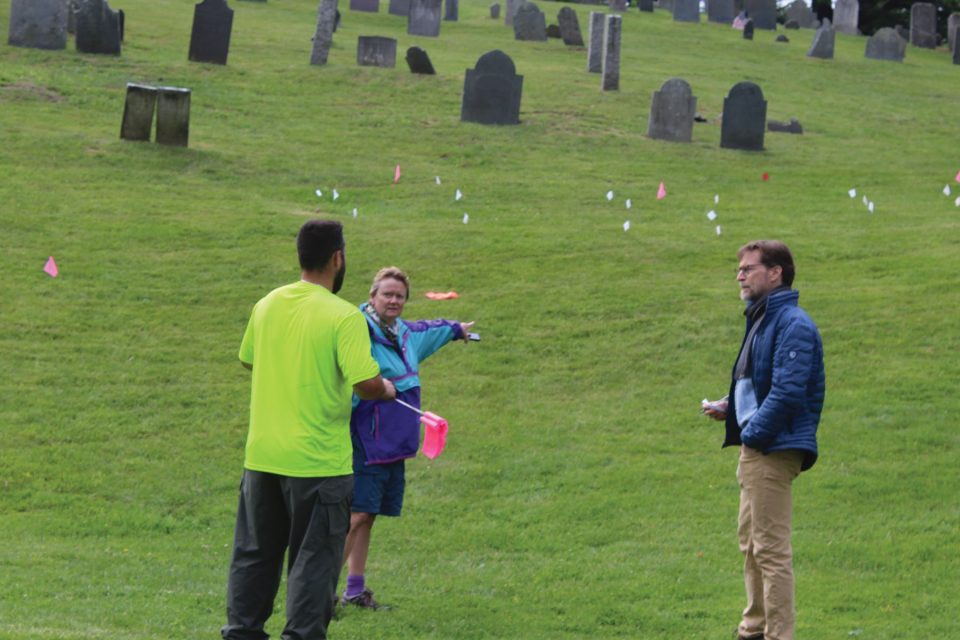NEWBURYPORT – The sounds of new homes being built wafted across Auburn Street last week as a group of historians, museum leaders and city employees watched Ed Balsky search for long-dead bodies on a hillside of the 18th Century Oak Hill Cemetery.
In an area of the cemetery about 75 feet by 75 feet, Balsky, who works with Sterling-based GeoSource, found at least 20 bodies, buried in shallow graves that had no markers.
They are not just any bodies, but probably are those of black residents who may have lived in what was once a neighborhood of mostly black families, known as Guinea Village. The historic neighborhood near Auburn and Low streets, which thrived with about 100 residents during much of the 19th century, is gone.
It is on a portion of that site along Auburn Street that the new homes are being built.
Local historians, including Bethany Groff Dorau, the executive director of the Museum of Old Newbury, and writer/historian Ghlee Woodworth, are confident that the bodies found near the Auburn Street entrance to the cemetery are black residents.
“It’s safe to say these are black peoples’ graves. I think we can go out on a limb. Most likely these are unmarked black graves,” Woodworth said.
Six graves in the area have headstones, most of whom have been identified to be black from their inscriptions and from old records.
Geordie Vining, senior planner with the city’s Planning Department, who has been doing and overseeing extensive research on the city’s black residents, said Newburyport was not large enough to have a separate black cemetery like larger cities. And some graves of black residents have been found in other cemeteries.
“This appears to be the black section,” Vining said. “Headstones cost a lot of money. They get buried. They didn’t get a marker. They get forgotten.”
The city, working with the Newburyport Black History Initiative, is working to make sure the black residents who worked, played and helped build the port city are not forgotten. Vining heads a team that is creating a dozen metal signs that will be placed in highly visible places about the legacy of African Americans here.
The first of the signs recognizes Guinea Village. Another will honor the black graves in Oak Hill.
One of the marked graves was for John C. H. Young, who owned a barber shop on Merrimac Street. A few feet away is a second grave marked as that for Nancy Haburn, who came from Baltimore, according to the inscription.
Between Young’s and Haburn’s grave, the radar found a third body that had no headstone. Woodworth and Dorau speculate that it may be the unmarked grave of Young’s wife, who also came from Baltimore. Haburn may have been a friend or relative.
“I am pleased that we have found these graves,” said Woodworth, who has written books about Newburyport history and conducts tours of Newburyport’s cemeteries. “But it’s sad that we will never know who they are. They were citizens.”
Dorau, who deals daily at the museum with speculation about historical figures, said, “It’s wonderful to think about people no one has thought about for years and years. It is a microcosm of the human experience.”
Vining, who used $1,450 of Community Preservation Funds to pay for the ground radar, is planning to honor the black section of the cemetery with an eight-by-10-inch plaque. At the suggestion of Nick Federico, a city engineer, who came to mark the graves with Global Positioning tags, Vining is also planning to mark each grave with a small square stone in the grass.
Woodworth also plans to stand up several small markers, apparently used on unidentified infant graves, to make them more visible above the grass.
Like many cemeteries, the black section of Oak Hill has an intriguing mystery. On the ridge overlooking the veteran’s cemetery, a marker identifies two bodies under one headstone. One of the deceased is known from records to have been black. The other may be white or possibly of mixed race.
“We’ll probably never know what their relationship was,” Woodworth said.
Black Deaths Matter
Tuesday June 13, 2023

Ghlee Woodworth, center, discusses the unmarked graves with Geordie Vining, right and Ed Balsky, left.



